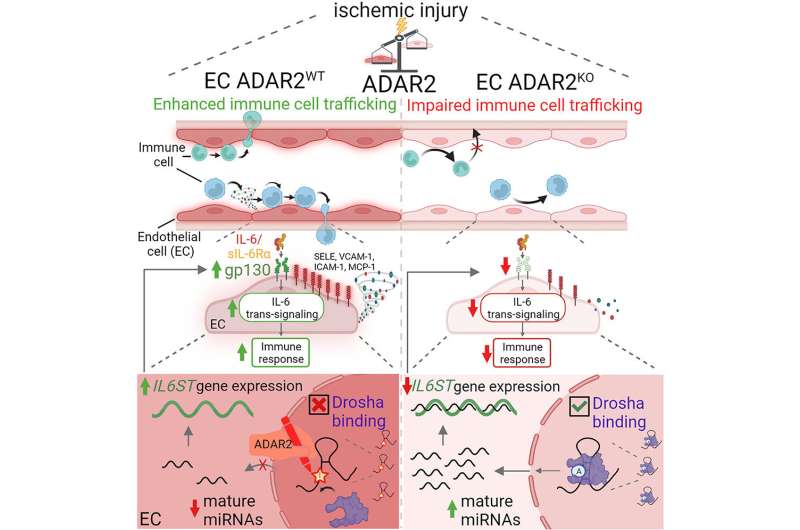This article has been reviewed according to Science X's editorial process and policies. Editors have highlighted the following attributes while ensuring the content's credibility:
fact-checked
peer-reviewed publication
proofread
RNA editing guides immune cells to areas of tissue injury

A team of international scientists led by the Heidelberg University, Medical Faculty Mannheim, and the Newcastle University (Great Britain) has succeeded in decoding a new mechanism of immune cell trafficking by examining vascular diseases. Surprisingly, the fine-tuning of this fundamental immune defense process is carried out by an RNA editing system (ADAR2) in the endothelial cells that line the blood vessels. This knowledge could open up new therapeutic approaches for a large number of inflammatory diseases.
When our body experiences an injury or becomes infected by pathogens, chemical signals called cytokines cause immune cells to leave the bloodstream and travel through the blood vessel wall to the site of the injury or infection. This process of immune cell trafficking is essential for the body's natural defense.
However, if this process is chronically activated, it can lead to chronic tissue inflammation and organ damage, which in turn promotes the development of chronic inflammatory diseases including heart disease and cancer. Immune cell trafficking is therefore an important parameter that can be used to regulate the inflammatory processes and is the focus of drug development for the treatment of a wide variety of diseases.
The international research team carried out its investigations using ischemic diseases as an example. During ischemic diseases our body experiences lack of oxygen in the affected tissue triggering the production of cytokines. The most common consequence of chronic ischemic heart disease is heart failure.
"Chronic inflammation is an important mechanism underlying ischemic heart disease. People who have had a heart attack are at high risk of having a second heart attack, developing heart failure, or experiencing other complications. If we understand how immune cells are recruited into the heart after an acute heart attack or in chronic ischemic heart disease, we can develop new therapeutics that may reduce this risk, known as residual risk," says Professor Konstantinos Stellos.
Together with the RNA biologist and first author of the study, Dr. Aikaterini Gatsiou, he did much of the work at the Newcastle University in the UK. With his move to undertake the Chairmanship of the Department of Cardiovascular Research at the Mannheim Medical Faculty, Heidelberg University in 2021, he continued his work from there.
The finding that an RNA enzyme orchestrates the inflammatory response in the heart or in other ischemic muscle tissues makes it a promising target for various inflammatory diseases. ADAR2 (Adenosine Deaminase Acting on RNA-2) precisely catalyzes the change of an RNA alphabet letter, called adenosine, to another letter, called inosine, at specific sites in RNA, a process termed RNA editing.
The researchers defined from single nucleotide resolution up to organ level the exact mechanism by which RNA editing controls immune cell trafficking in ischemic diseases.
"We believe that a significant obstacle in rapidly developing new therapies is the tendency of basic research studies to base scientific observations on a single level of analysis. Since we are multilevel organisms, efforts to discover new pathways that could be pharmacologically targeted would be most effective if all mechanistic levels are explored and tested using human and murine primary cells, experimental disease models, and human biopsies. This is exactly what we had in our mind when designing this investigation, which was implemented with the help of several experts from various research fields who significantly contributed to this study," explain Professor Stellos and Dr. Gatsiou.
The RNA enzyme ADAR2 may not only be a therapeutic target itself, but its activity may be used as an alternative tool to genome editing technologies. DNA editing using CRISPR/Cas9 gene scissors now enables scientists to specifically modify an organism's DNA in order to correct diseases. However, the technology also harbors risks, as it leads to irreversible changes in the DNA.
"The use of RNA editing represents a more promising approach for the development of therapies for inflammatory diseases such as heart failure, cancer and autoimmune diseases. RNA editing does not touch the DNA, it is very specific and the effect is reversible and doseable due to the short life-time of RNA. Our study provides an integrative framework for such efforts," says Dr. Aikaterini Gatsiou. "Interestingly, several research groups are working on the exploitation of human ADAR enzymes as controllable RNA editing machines," adds Professor Stellos.
Considering that inflammation is a common mechanism in several pathologies, the findings of this work can revolutionize the treatment of many diseases. The results were published online today in Immunity.
More information: Aikaterini Gatsiou et al, The RNA editor ADAR2 promotes immune cell trafficking by enhancing endothelial responses to interleukin-6 during sterile inflammation, Immunity (2023). DOI: 10.1016/j.immuni.2023.03.021



















